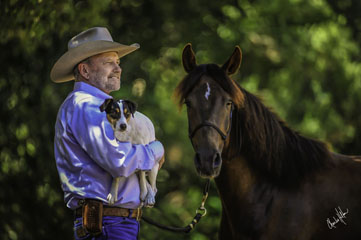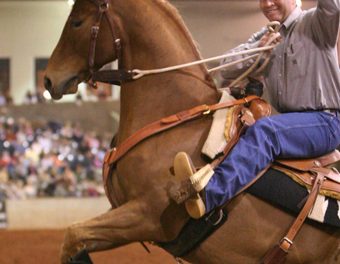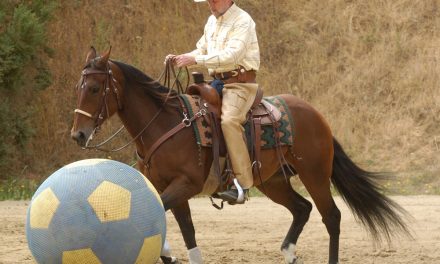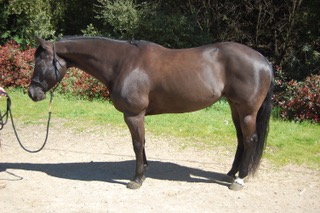
Lacy and Toby
Feeding horses by hand is a pet peeve of mine and I want to talk about it in detail, giving the pros and cons and why I am against it. In the horse industry there are a lot of people who hand feed their horses. It is a way to have communication with the horse, a way of showing affection and a way of accommodating his needs. It is a loving moment. On the other hand, some horses begin to expect the treat and become pushy and aggressive, crowding into the person’s space.
There are trainers that use treats in training and that is called clicker training. The horse learns and is motivated by food. However, there comes a time when the horse needs to transition away from the treat and learn without that motivation. Most of these trainers will tell you that the transition can be a real problem.
In regard to hand feeding horses, number one, I have been bitten many, many times. I have had a lot of horses here at the ranch who were dangerously aggressive because they had been hand fed. It has taken a lot of assertiveness on my part to correct this behavior. There is also a small percentage of horses that can be hand fed and will never do anything that would be destructive or cause anyone harm. By the time you find out if your horse fits into this category, it may be too late.
I have a personal friend who was bitten and lost 30 percent of the use of his left arm because a horse bit into his muscle. A woman acquaintance of mine lost part of her breast. Neither of the horses involved were aggressive, they were just looking for treats that they had come to expect. In the case of the woman, she always kept the treats in the breast pocket of her shirt and the horse knew that. I have been picked up by the back of my jacket by a horse and thrown across the stall. I trace this behavior back to the horse getting aggressive looking for food. A horse has very strong jaws and can do real damage.
It also might be fine to hand feed your horse if no one else is ever around him. The problem is that there are always other people who come around your horse from time to time. If you are at a facility, there are other riders and stable hands near your horse. If you stable at home, there is the farrier, the veterinarian and other family members. It may not show up immediately but down the road a horse that is hand fed treats may become pushy and aggressive. When a horse comes into my space looking for treats, I correct it because if I don’t, it can be a problem later on. Horses learn by pressure and release. When you allow your horse to be in your space, whether or not he is looking for food, you are teaching him that it is okay to crowd you and he will do it again next time. To correct a horse from crowding we must be assertive and back the horse up using the lead rope or a dressage stick. There must be enough pressure so that the horse moves his feet. Correction does not mean beating the horse but it must be enough to let the horse know that he needs to back off. We don’t usually have a problem with this behavior here at the barn and I want to keep it that way because that rude invasion of our space can quickly turn to aggression and get out of control.
The way that we can give our horse a treat is to put the food in a bucket or a feeder. The horse may learn to go to the feeder to get a carrot and as long as there is no negative behavior associated with that, it is not a problem. The idea is to keep the situation safe. Safety is always a primary concern for me. I personally believe that a horse can understand the difference between being hand fed and getting a treat in the feed bin. I truly believe that you can give your horse a treat in the bin and go on to work the horse and the horse will be well behaved and not look for additional treats as you are handling him. I am a behaviorist and I see where the behavior problems around ground manners arise. Even the people who clicker train recognize that this can cause a horse to become pushy and rude and come into the trainer or rider’s space.
I sometimes have a hard time convincing my clients and those who come to me for clinics about the importance of having a horse with consistently good ground manners. How am I going to be able to teach the horse to accept treats and then teach him to behave when he is not going to have a treat? In my experience, the horse usually gets the upper hand. I’ve had a lot of horses in training who have really gotten aggressive when they were hand fed. There is an element of danger when working with a horse and we always try to stay on the side of safety.
Just a little over a year ago, there was a young lady on the ranch who insisted on hand feeding her horse, even after I asked her not to. She lost a finger tip. It was a simple mistake; the horse was not being aggressive. The horse simply took the cookie and the tip of her finger got in the way. The good news is, the finger tip was recovered and was able to be reattached. Horses are dangerous anyway and this is simply a safety issue. Most of the horses here at the ranch are good minded and quiet but you never know and we try not to set up dangerous situations. We need to use common sense and good judgement to set ourselves and our horses up to be successful for the safest and most enjoyable riding experience.





